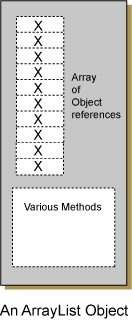String[] list = new String[3];
list[3] = "dog" ;
An ArrayIndexOutOfBounds exception is thrown and
(usually) the program halts.
ArrayList class
The ArrayList class builds upon the capabilities of arrays.
An ArrayList object contains an array of object references
plus many methods for managing that array.
The biggest convenience of a ArrayList is that you can
keep adding elements to it no matter what size it was originally.
The size of the ArrayList automatically increases
and no information will be lost.
However, this convenience comes at a price:
ArrayList must be object references,
not primitive data like int or double.ArrayList operations are slightly slower than array operations.
In the picture, "X" shows that a cell is empty.
The ArrayList in the picture is completely empty.
The "X" is conceptual;
the actual implementation of ArrayList uses
an unspecified means to keep track of empty cells.
Note: "X" is not the value null.
If null is placed in a cell, the cell is regarded as containing data.
(Thought Question: ) Say that you want a list of int values.
But an ArrayList can contain only object references.
How can you use an ArrayList to store your ints?
(Click for a hint.)